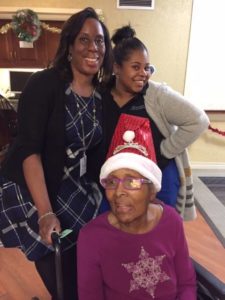When Carolyn Carozza moved into St. Elizabeth Rehabilitation and Nursing Center more than two years ago, it was her fourth stint in rehabilitation – this one brought on by a fall – and she wanted to go home. She missed her apartment and her own things, said her daughter Darby McKaine, even after they brought in her comforter and hung familiar artwork on the walls.
But her tone began to change as she got to know members of the staff – the man from maintenance who helped hang pictures, the woman who cleaned the room, the nurses who cared for her every day, the chef who came to understand her menu preferences.
“Now, when we bring her out for a family get-together or birthday party, she says, ‘OK, I’m ready to get home,’” said McKaine. “We’ve offered for her to come and live with one of us, but she likes her routine. The reason my mother’s doing so well is that she gets such great care there.”

Taken during the Christmas season (before social distancing and PPE)
The quality of care is driven by the commitment of the staff, said Edwina Bell, director of nursing at St. Elizabeth. It is a characteristic that distinguishes the Catholic Charities-run nursing home, which neighbors Saint Agnes Hospital in Southwest Baltimore.
“Everybody wants to be here,” she said. “When you watch people work, you can tell they have attachments to a lot of the residents. They know them. They know what time they want to go bed. They know what they like to eat. We all get very attached.”
Administrator Zachary Richards said this attachment has also helped the facility rally around elder residents, even during a global pandemic.
As COVID-19 spread, St. Elizabeth had to cut group activities and interactions, suspend visits from family, friends and volunteers, and close some on-site amenities – all dramatic changes for residents, their families, and staff. But Richards said his team stepped up in new ways. When the facility’s hair salon closed, for example, one staff member ordered supplies and began painting residents’ nails, while two geriatric nursing assistants began cutting and styling residents’ hair.
“They’re bringing that sense of personal connection,” he explained.
The values guiding St. Elizabeth are clear. Every morning, a prayer rings across the facility – which “helps people maintain focus, even if they’re not Catholic,” Richards said. As social distancing related to the novel coronavirus prevented gatherings, the facility started broadcasting daily Mass and prayer groups through an in-house TV channel.
The facility itself is also designed to make residents feel at home. Call bells ring to pagers to avoid constant beeps or chimes. Medical equipment is moved from hallways as quickly as possible, both to remove tripping hazards and to prevent the feel of a medical institution. Lamps brighten residents’ rooms rather than sterile overhead lights, and mailboxes label residents’ doors instead of name tags. And Corozza’s daughter said that, although Corozza made a purposeful effort to get to know her roommate, it made a difference that a wall separated their living space instead of a curtain.
St. Elizabeth also works hard to foster with residents’ families. Bell, for example, provides her cell phone number to family members and tries to stay abreast of clinical developments, even when she’s not in the care area. This familiarity matters, particularly in times of crisis.
“One person called today and said, ‘Edwina, my mother sounds different. She sounds like she may be more confused than usual. Can you go in and check on her?’” Bell said, adding this approach drives the care delivered to every resident at St. Elizabeth.
“They’ve lived their life,” she said. “You want to honor that life … and give them the dignity and respect that they’ve earned at this point in their lives.”
